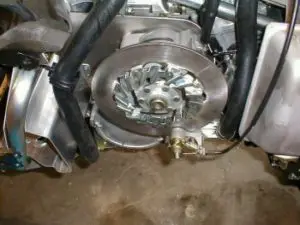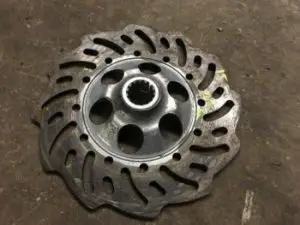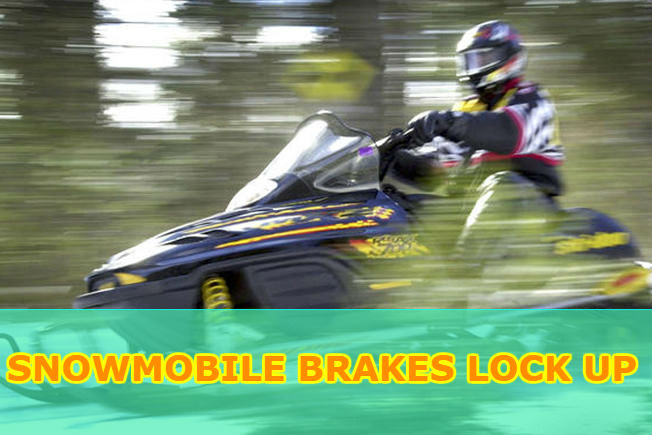There is nothing worse than going out for a cruise on the local trails with your buddy and your snowmobile’s brakes lock up. Do not worry though we’ll tell you what to do when they do lock up and how to make sure you can get home safely.
The single most important thing to do when your brakes lock up is not to panic. Panicking will make everything else harder, make it easier to make a mistake and generally is not a great thing to be doing in a winter environment. Always sit back, clear your head and then start to work on solutions.
What to do if your brakes lock up
 As we said above, do not panic. The first and straightforward thing to do would be to check to see if your parking brake has been left engaged. If it has, release it and carry on with your day out. If it hasn’t, well now we need to start looking for other issues.
As we said above, do not panic. The first and straightforward thing to do would be to check to see if your parking brake has been left engaged. If it has, release it and carry on with your day out. If it hasn’t, well now we need to start looking for other issues.
If you can smell burning as well, your brakes may be overheating; a few problems can cause this. The quickest and easiest way to carry on is to pop some snow on your brakes. Snow should cool them down and bring down the expansion that caused your brakes to expand and lock on. Try and take it easy on the way home to not make the issue worsen again.
A quick note on if you smell burning. If you smell burning stop straight away. Many sleds have plastic fuel pipes very close to the brake rotors. Powering through can lead to a nice fire, both in your sled and to your bank balance as you have to buy a new sled and tow a wreck out of the wilderness.
Brakes still jammed on?
If your brakes are still jammed on, it could be that you have moisture or just old brake fluid in your brakes hoses. You can take open up your brake bleed port, and this should help to relieve the pressure on your caliper and free it from the disc.
I would also think about opening up your brake fluid reservoir cover; it should be up there beside your brake lever. You should be able to see a small return port that bleeds pressure back into your reservoir. It will be a tiny hole, so you will need something like a pin to unblock it, you do carry a pin with you? There is a simple test to know if this is blocked. Once you have the cover off, pull your brake lever. If fluid squirted out, possibly hitting your face, then the hole is okay and not blocked.
How to get home with brake failure
 If none of the above help you and you are in the middle of nowhere it is time for a risky venture. Take out the pin that holds the brake pads in your caliper. It may take a bit of work to get the pads out. If they fall straight out your brakes weren’t jammed on
If none of the above help you and you are in the middle of nowhere it is time for a risky venture. Take out the pin that holds the brake pads in your caliper. It may take a bit of work to get the pads out. If they fall straight out your brakes weren’t jammed on
Now with your pads out, put them somewhere safe. Now it is time to limp home, very slowly and only along as safe a route as you know. You will not be able to stop fast, so do not try anything risky just now. Just ease yourself home, it is better to take your time than to rush this and never get home.
If you can not get your brake pads out and you are completely stranded. Now is the time to call your friends or start a long walk to get them. Get your friends to come with a piece of carpet or vinyl to put under your sled’s tracks, turning your sled on the side will make this a lot easier. Zip tie this in place. Then get one of them to pull you and your sled to safety. The carpet should help to save your track’s lugs from being unduly damaged.
Bleed your snowmobile brakes
One of the most common reasons for your brakes jamming on is that your brake fluid needs bled. Your seals are not infallible, and over time debris, moisture, and air can all creep into your brake system. Causing the pressure to build up in your brake pipes and your caliper to jam on.
A brake bleed is a pretty easy to fix.
- Grab a hose and fit it over your caliper bleed screw and put the other end in a container. If the hose is clear you will be able to see the air leave the caliper.
- Loosen the screw. You should be able to turn the screw and hose with a spanner of the correct size. You will now be happy that you did step one as the fluid will be going into the container and not all over your snowmobile.
- Take the cover off your brake reservoir.
- Pump your brake lever. While pouring new fluid into the reservoir. Do not let the fluid get too low in the reservoir or you will pull air into your brake line.
- Repeat pumping and putting new fluid in until the fluid coming out is the same as the fluid going in. This is again why a clear hose is best.
- Tighten the bleed screw.
- Top up reservoir if needed.
- Replace the reservoir cap.
- Jack up the back of your sled and make sure your brakes work before heading out.
- Make sure to clean up spilled brake fluid; it is a tad corrosive.
See, it is simple and pretty easy to do in your garage. Bleeding your brakes should eliminate most problems with brakes locking on when you are out on the trails.
Snowmobile brake fault checklist
If bleeding the brakes does not help you, then we have a few quick ways to help you to discover what else may be the issue.
- Check the brake rotor and make sure it is not warped. With the extra heat from being jammed the rotor may have warped out of shape and is now jamming the pads. Fixing this is nice and easy, either bend the rotor back into shape or fit a new one if you feel t is too warped to be saved.
- If this is not the case, ride your sled till the brake starts to lock on again, this time though jack it up while the brake is still hot. Look at your master cylinder, and you should see an outlet at the reservoir, unscrew this line. If your brake releases here then you have a master cylinder issue. Check the seal on your master cylinder and make sure it has not degraded and is letting debris in.
- If that does not work for you, then look at your bleed screw again. If you unscrew this and the brake releases, then you have an issue in your brake hose and will be needing to replace your brake hose.
- If none of these options works for you, you will very probably be looking at taking apart your caliper and rebuilding it with a new seal kit. Rebuilding a cylinder is another relatively simple job but before you order the new seal kit, check the pistons seal. Does it have rust or any debris on it? Using compressed air blast the seal. Does this clear the seals? If so you have sorted the problem, if not a rebuild is on the cards.
- If you don’t want the risk, you can get a new caliper and install it on your sled. You can even find them on Amazon, like this one.
How do snowmobile brakes work?
 There is no point in trying to fix your brakes if you do not know the basics of how snowmobile brakes work. The first thing a snowmobile brake has to be is rugged, can you imagine the stresses of starting at -40 ° and then having to still work at high temperatures as your engine runs.
There is no point in trying to fix your brakes if you do not know the basics of how snowmobile brakes work. The first thing a snowmobile brake has to be is rugged, can you imagine the stresses of starting at -40 ° and then having to still work at high temperatures as your engine runs.
This considerable temperature change is one of many reasons why you should not skimp on brake parts for your snowmobile.
Snowmobiles brakes work like most cars and bikes; they use a hydraulic system to activate pistons in a clapper which press brake pads against a rotor. Simple. Imagine you are racing down a trail, you press a lever with your hand, do you think this would stop all the forward momentum you have built up?
It very probably wouldn’t so this is why we have hydraulic brakes, invented in 1919 by Malcolm Loughead. The basic principle is that you squeeze the hydraulic fluid through a narrow pipe, this helps to build pressure. When It hits the piston in your caliper, it has a lot more power than you pulled your lever with. The fluid then pushes the brake piston and then the brake pad against the rotor. Slowing you down effectively.
Wrap up
Brakes are not as scary as you think they will be to work with. If you take your time and do not rush you will have no problems what so ever in looking after your sled. The hardest part will be to make sure you do not get stressed or panicked when out in the wild, as that is when mistakes do happen. With a clear head, you will be back on the trails in next to no time.
If you have other tips, please share them in the comments below.
Happy sledding and remember always to have fun. Remember to check our recommended products page for some tips.
